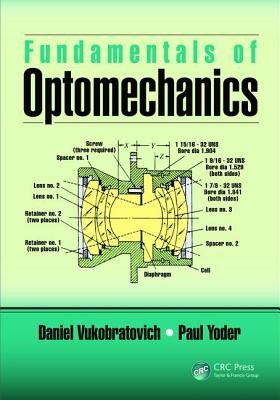
- We will send in 10–14 business days.
- Author: Daniel Vukobratovich
- Publisher: CRC Press
- Year: 2018
- Pages: 462
- ISBN-10: 1498770746
- ISBN-13: 9781498770743
- Format: 17.8 x 25.4 x 2.5 cm, kieti viršeliai
- Language: English
- SAVE -10% with code: EXTRA
Reviews
Description
When Galileo designed the tube of his first telescope, optomechanics was born. Concerned with the shape and position of surfaces in an optical system, optomechanics is a subfield of physics that is arguably as old as optics. However, while universities offer courses on the subject, there is a scarcity in textbook selections that skillfully and properly convey optomechanical fundamentals to aspiring engineers. Complemented by tutorial examples and exercises, this textbook rectifies this issue by providing instructors and departments with a better choice for transmitting to students the basic principles of optomechanics and allowing them to comfortably gain familiarity with the field's content. Practicing optical engineers who engage in self-study and wish to enhance the extent of their knowledge will also find benefit from the vast experience of the authors. The book begins with a discussion of materials based on optomechanical figures of merit and features chapters on windows, prisms, and lenses. The authors also cover topics related to design parameter, mounting small mirrors, metal mirrors with a discussion of infrared applications, and kinematic design. Overall, Fundamentals of Optomechanics outfits students and practitioners with a stellar foundation for exploring the design and support of optical system surfaces under a wide variety of conditions.
- Provides the fundamentals of optomechanics
- Presents self-contained, student-friendly prose, written by top scientists in the field
- Discusses materials, windows, individual lenses and multiple lenses
- Includes design, mounting, and performance of mirrors
- Includes homework problems and a solutions manual for adopting professors
EXTRA 10 % discount with code: EXTRA
The promotion ends in 23d.05:36:42
The discount code is valid when purchasing from 10 €. Discounts do not stack.
- Author: Daniel Vukobratovich
- Publisher: CRC Press
- Year: 2018
- Pages: 462
- ISBN-10: 1498770746
- ISBN-13: 9781498770743
- Format: 17.8 x 25.4 x 2.5 cm, kieti viršeliai
- Language: English English
When Galileo designed the tube of his first telescope, optomechanics was born. Concerned with the shape and position of surfaces in an optical system, optomechanics is a subfield of physics that is arguably as old as optics. However, while universities offer courses on the subject, there is a scarcity in textbook selections that skillfully and properly convey optomechanical fundamentals to aspiring engineers. Complemented by tutorial examples and exercises, this textbook rectifies this issue by providing instructors and departments with a better choice for transmitting to students the basic principles of optomechanics and allowing them to comfortably gain familiarity with the field's content. Practicing optical engineers who engage in self-study and wish to enhance the extent of their knowledge will also find benefit from the vast experience of the authors. The book begins with a discussion of materials based on optomechanical figures of merit and features chapters on windows, prisms, and lenses. The authors also cover topics related to design parameter, mounting small mirrors, metal mirrors with a discussion of infrared applications, and kinematic design. Overall, Fundamentals of Optomechanics outfits students and practitioners with a stellar foundation for exploring the design and support of optical system surfaces under a wide variety of conditions.
- Provides the fundamentals of optomechanics
- Presents self-contained, student-friendly prose, written by top scientists in the field
- Discusses materials, windows, individual lenses and multiple lenses
- Includes design, mounting, and performance of mirrors
- Includes homework problems and a solutions manual for adopting professors


Reviews